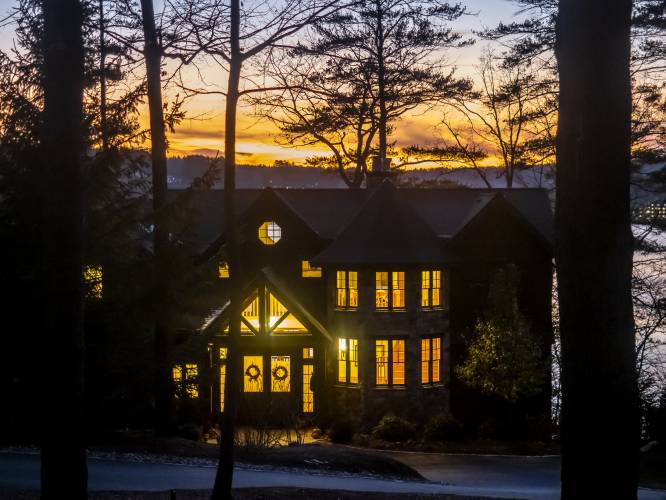Moultonborough, Laconia saw largest population increases in last decade, number of homes available not keeping up

A luxury home on the east side of Lake Winnipesaukee in Meredith. GEOFF FORESTER
| Published: 04-29-2025 5:11 PM |
A report compiled by the Lakes Region Planning Commission indicates the broader Lakes Region significantly lacks available housing.
The 2023 Lakes Region Housing Needs Assessment details strong population growth over the past 20 years, and a distinct lack of available housing. The local experience over that time period closely mirrors conditions throughout New England, according to the report.
“Housing trends in the Lakes Region are very similar to trends experienced by the rest of the state, and much of New England, over the last decade,” the report reads. “Throughout New England, population has increased faster than the number of housing units driving up prices, while wages have not kept pace. In the Lakes Region, we have another unique problem resulting from the second vacation home market. The additional demand for housing in the region increases land and building prices and reduces the percentage of the housing stock available for year-round and nonseasonal use.” Their study estimated a need for 372 total units per year — including 158 affordable units — through 2040. That’s 7,440 units total, including 3,160 affordable units.
The report sought to investigate four core questions: Are there enough housing units for people who work in the Lakes Region at present?; Is the available housing adequate and affordable for those people?; Can we expect adequate and affordable housing to be available for those living and working in the Lakes Region in the future?; and if the answer to the previous three questions turns out to be ‘no’, What steps can be taken to address them?
The Lakes Region covers all of Belknap County and includes portions of Carroll, Grafton and Merrimack counties. Municipal populations in the Lakes Region tend to be rural in nature, and range from under 1,000 people, like in Hebron, to over 17,000, like here in Laconia. There’s limited public transportation, and, while many individuals live in the area year-round, many others are unable to find affordable housing and commute extensive distances to work here.
The population of year-round residents in the Lakes Region increased slightly more between 2000 and 2010 than it did between 2010 and 2020, but both periods experienced growth. In the period 2010 to 2020, the population grew 4.6%, or by about 5,500 people. From 2000 to 2010, the population increased more, 6.6% or by about 7,400 people, according to their report.
A 2022 report from the New Hampshire Office of Planning and Development projected those trends would continue, likely until 2040, before slowly leveling off and going into decline.
Among Lakes Region municipalities, Moultonborough experienced the highest population growth rate between 2010 and 2020, at 22%, and the second largest increase in population at 874. Laconia had the largest increase in population with 920 new residents, followed by Alton and Gilford at 644 and 573, respectively.
Article continues after...
Yesterday's Most Read Articles
 With Steeplegate still held up in court, city privately debates public investment
With Steeplegate still held up in court, city privately debates public investment
 State budget mandates sale of mental health housing in Concord
State budget mandates sale of mental health housing in Concord
 ‘Peace of mind’: As New Hampshire nixes car inspections, some Concord residents still plan to get them
‘Peace of mind’: As New Hampshire nixes car inspections, some Concord residents still plan to get them
 Former Castro’s building to hold apartments and the cigar shop will return, eventually
Former Castro’s building to hold apartments and the cigar shop will return, eventually
 Sudden pile of trash near Exit 13 on Manchester Street in Concord considered ‘illegal dumping’
Sudden pile of trash near Exit 13 on Manchester Street in Concord considered ‘illegal dumping’
 Mullet madness: Young man who died in motorcycle accident remembered at local fundraiser
Mullet madness: Young man who died in motorcycle accident remembered at local fundraiser
Conversely, the populations of Ashland, Hill, Center Harbor, Holderness, Plymouth and Belmont decreased, to varying degrees, over the same time period.
The study identified several factors likely to influence the future supply of housing, housing affordability and the cost of developing new housing: the overall supply, which is generally provided by the private sector and subject to market influences; tourism, which the Lakes Region’s economy is largely dependent on and increases demand for short-term rental availability; remote work, which became increasingly common post-COVID pandemic; changing demographics; and development opportunities in terms of available land which can be developed based on rules governed by zoning, land costs, construction costs and infrastructure.
Over the previous 20 years, the Lakes Region labor force has varied slightly, but mostly remained consistent. Over that period, it’s always been between 60,000 and 65,000 people and corresponding unemployment rates have ranged between 2.4% and 6.7%. In the period between 2009 and 2019, the number of jobs in the region increased 10%. More than 60% of jobs are dispersed between just five industries: retail; health care and social assistance; education; accommodations and food service; and manufacturing.
Almost half of the region’s renters are low-income households. The total percentage of low-income renters is larger than the proportion of low-income homeowners, at 49% and 16%, respectively. The assessment notes those figures indicate a need for rental housing assistance programs in the Lakes Region.
The overall number of housing units increased by 1,174 between 2010 and 2020, but only about two-thirds of those units are considered occupied — the other third are listed as vacant and are most likely seasonal. The growth rate of available units is much slower than the rate of population growth, which was 4.6% between 2010 and 2020 — the growth rate of housing was just 1.5%.
“There has been some growth in the number of housing units, however not as much as the population has grown. About two-thirds of the housing in the Lakes Region is considered vacant, including seasonal housing,” the report reads. “Much of the housing that has become available in the past decade is due to formerly vacant (seasonal) housing being converted to occupied housing.”
The Lakes Region has a much higher rate of vacant, mainly seasonal, housing units compared to the rest of New Hampshire. In 2020, the Lakes Region proportion was twice as high as the state writ large, and might be attributed to the Lakes Region’s identity as a vacation destination with many second homes. A statewide look at short-term rental properties found there were 5,500 units available statewide, with nearly a quarter of those found in the Lakes Region.
Throughout the region, there were 2,238 income-restricted housing units, about 4% of the total number of housing units. About half of those are designated for families, the elderly or those with mental or physical disabilities. Of the 31 communities comprising the Lakes Region, 16 have income-restricted units: Laconia had the most at 569 and Franklin was second, with 389 income-restricted units.
The region’s housing market also inflated significantly. Between 2000 and 2020, home sales prices increased more than twice-over, from $142,000 in 2002, to $359,966 in the first half of 2022. Over the same period, a 20% down payment increased from $28,400 to $71,993. Median rent for an apartment also increased, from $867 in 2009, to $1,109 in 2022, a jump of 28%.
Over the past decade, the proportion of renters who were overburdened, meaning they dedicated more than 30% of their income to rent, increased across all income levels. Nearly half of all households earning between $35,000 and $50,000 were overburdened.
The study identified several factors likely to influence the future supply of housing, housing affordability and the cost of developing new housing: the overall supply, which is generally provided by the private sector and subject to market influences; tourism, which the Lakes Region’s economy is largely dependent on and increases demand for short-term rental availability; remote work, which became increasingly common post-COVID pandemic; changing demographics; and development opportunities in terms of available land which can be developed based on rules governed by zoning, land costs, construction costs and infrastructure.
The population of the Lakes Region is projected to continue to increase through 2040, by 12,385 persons or about 10%.
To read the entirety of the 2023 Lakes Region Housing Needs Assessment, navigate to lakesrpc.org.
“Through several versions of the Lakes Region Housing Need Assessments stretching back nearly two decades, the message has been consistent that there continues to be a need for more housing throughout the region. Not one-size-fits-all housing, not just single-family homes, but a mix of housing options,” the study reads.
“A sufficient variety of housing allowing reasonable options for the single person or couple starting out, for the growing family, and for those of us who might be downsizing later in life must be made available.”
These articles are being shared by partners in the Granite State News Collaborative. For more information, visit collaborativenh.org.







 ‘Entire paradigm has to shift’: Majority of parents express support for phone ban, but predict rocky rollout
‘Entire paradigm has to shift’: Majority of parents express support for phone ban, but predict rocky rollout New Hampshire committee seeks to prevent domestic fatalities like murder-suicide in Berlin
New Hampshire committee seeks to prevent domestic fatalities like murder-suicide in Berlin ‘A little piece of everything I like’: New Pittsfield barbershop brings more than a haircut to downtown
‘A little piece of everything I like’: New Pittsfield barbershop brings more than a haircut to downtown
